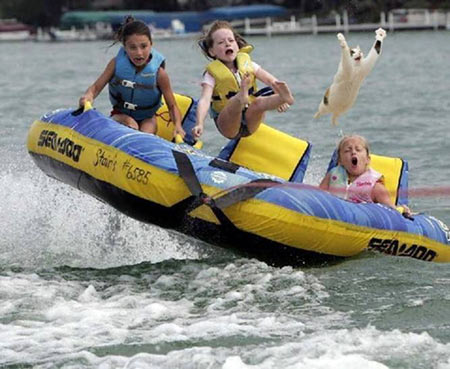 A
CAT-ASTROPHE -- It's important that ALL boaters wear pfds! A
CAT-ASTROPHE -- It's important that ALL boaters wear pfds!PAGE, Ariz. – After a series of recent accidents in Glen Canyon
National
Recreation Area, Superintendent Kitty Roberts is reminding
visitors to
think of safety when visiting the park.
Superintendent Roberts
said, "Long,
hot summer days can be some of the most fun, but visitors should
always
remember to take appropriate precautions when visiting Glen
Canyon.
"Wear your life jacket, drink plenty of water, watch the
weather, keep an eye on
your kids, and know your limits."
Summer monsoon thunderstorms can bring dangerous lightening,
hail, rain,
and winds. On July 30, a visitor from Gilbert, Ariz., was killed
when lightening directly struck him while he was riding a personal
watercraft on Lake Powell near Wahweap marina.
On July 31, another visitor, also from Gilbert, was struck by
lightening at Lone Rock beach. This man was treated on scene by
park rangers and flown by Classic
Lifeguard to the Page Hospital, where he was evaluated and
released.
Thunderstorms can be dangerous to boaters on Lake Powell. Last
Sunday
afternoon, two boats were swamped during the storms, and six
people found
themselves in the waters of Lake Powell.
They were pulled from the water by Utah State Parks rangers.
Fortunately, they were wearing life jackets and there were no
injuries.
Boaters should get out of the main channel and seek shelter on
shore during storms. The National Park Service also broadcasts
updated weather information on marine band channel 16.
In another end-of-July incident, park rangers were involved in
the rescue of a
14-year old boy from Pismo Beach, Calif., who had fallen near Oak
Bay, just north of Rainbow Bridge.
The boy was scrambling with
other kids up a steep slickrock ridge, when he lost his footing
and slid over 20 vertical feet, presenting back and leg injuries.
A Classic Lifeguard helicopter was dispatched to the scene.
Seven National Park Service staff responded and were assisted by
the boy’s family and other visitors in the area.
The boy was lowered approximately 350 vertical feet using
technical rescue gear to a safe landing zone. He was transported
to the Flagstaff Medical Center and is recovering.
Visitors also need to recognize the dangers of carbon monoxide.
There have
been recent incidents of carbon-monoxide poisonings at other lakes
in Arizona.
Carbon monoxide is produced by any boat’s engine or generator
and is odorless and colorless. Never swim or play near a boat’s
exhaust, and don’t let engines or generators idle unnecessarily.
www.nps.gov/glca
|
 September
2006
September
2006 September
2006
September
2006